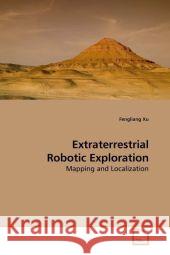Extraterrestrial Robotic Exploration : Mapping and Localization » książka
Extraterrestrial Robotic Exploration : Mapping and Localization
ISBN-13: 9783639205855 / Angielski / Miękka / 2009 / 176 str.
In an extraterrestrial environment such as on Mars or the Moon, there are no maps, signs, or GPS, and the topology is similar in all directions. How can a robot navigate avoiding hazards and find its way to destination? A practical solution is to generate various maps on site (mapping) and locate self within the map (localization). The first step is map generation from orbital, descent, and ground images. Robot uses terrain/slope map for hazard avoidance, contour map for safe route selection, orthomap for landmark identification, and traverse map for retrospection and planning. The second step is to determine current location by matching landmarks such as rocks, craters, or even remote mountain tops between current view and maps, and then dynamically adjust direction to destination. This book presents highly automated mapping and photogrammetry-based localization techniques developed for several Mars exploration experiments and missions including 1997 Mars Pathfinder and 2004 Mars Exploration Rover. The methods discussed are applicable to future missions to the Moon, Mars, and other planets.











